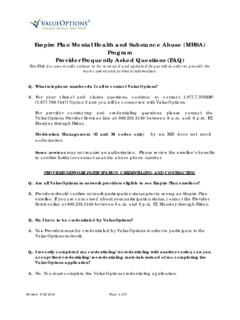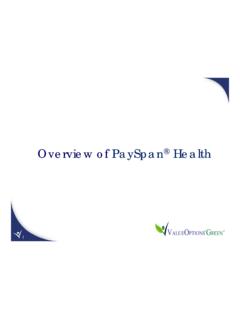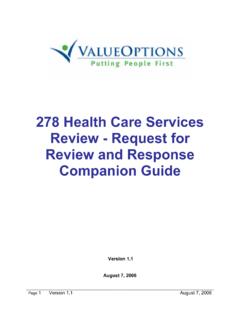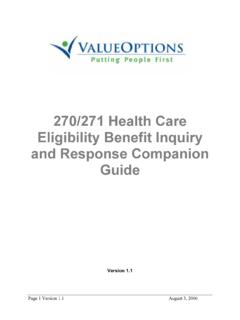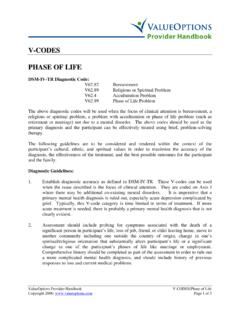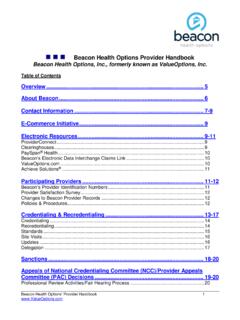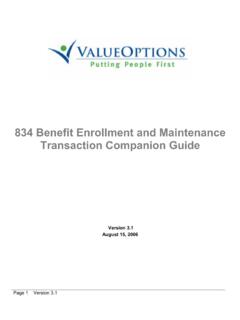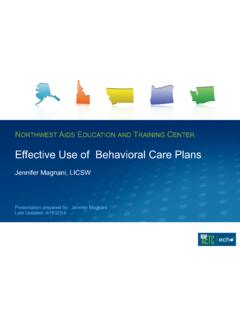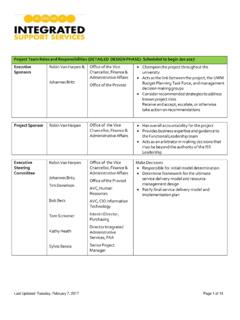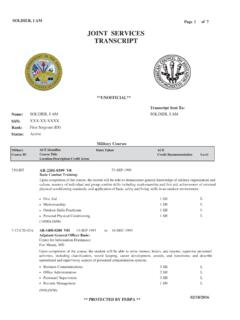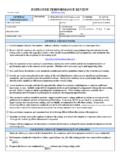Transcription of V-CODES RELATIONAL PROBLEMS
1 V-CODES . RELATIONAL PROBLEMS . DSM-IV-TR Diagnostic Codes: RELATIONAL Problem Related to a Mental Disorder or General Medical Condition Parent-Child RELATIONAL Problem Partner RELATIONAL Problem Sibling RELATIONAL Problem RELATIONAL Problem Not Otherwise Specified The above diagnostic codes will be used when the focus of clinical attention is a RELATIONAL problem, which includes patterns of interaction between or among members of a RELATIONAL unit that are associated with clinically significant impairment in functioning, or symptoms among one or more members of the RELATIONAL unit.
2 Or impairment in the functioning of the RELATIONAL unit itself (DSM-IV-TR). The above codes should be used as the primary diagnosis and participants can be effectively treated using brief, problem-solving therapy. The following guidelines are to be considered and rendered within the context of the participant's cultural, ethnic, and spiritual values in order to maximize the accuracy of the diagnosis, the effectiveness of the treatment/intervention, and the best possible outcomes for the participant and the family and the extended family where culturally appropriate.
3 Diagnostic Guidelines: Establish diagnostic accuracy as defined in DSM-IV-TR. The distinguishing feature of these V- codes is that the issue is the focus of clinical attention and is a pattern of interaction between the members of the RELATIONAL unit that is associated with clinically significant impairment in one or both members of the RELATIONAL unit. It is imperative that a primary mental health diagnosis be ruled out. This can be applied to two or more members of the RELATIONAL unit who are being treated for the problem. When these PROBLEMS are the principal focus of clinical attention, they should be listed on Axis I.
4 Otherwise, if they are present but not the principal focus of clinical attention, they may be listed on Axis IV. 1. Assessment should include probing for symptoms associated with PROBLEMS in relationships. Comprehensive history should be completed as part of the assessment in order to rule out a more complicated mental health diagnosis, and should include history of previous relationships, prior interventions concerning relationships, current and past work difficulties and current medical PROBLEMS . ValueOptions Provider Handbook V-CODES / RELATIONAL PROBLEMS Copyright 2006: Page 1 of 5.
5 2. Consider the following behaviors and/or symptoms: a. Recurring arguments and conflict between two individuals which cause preoccupation and/or distract from activities of daily living. b. Lack of communication and/or withdrawal between the individuals which results in frustration and/or anger. c. Inappropriate kinds of communication between individuals which can include unrealistic expectations, withdrawal, or criticism. d. Avoidance of the individual who is felt to be causing the stress. Individuals can spend too much time at school, work, or friends' homes to avoid contact with the other person.
6 E. Stress related to threat of separation either by running away' (for a child), or marital separation (for adults). f. Increased irritability, sleeplessness, depression, and/or social withdrawal. g. A pattern of angry responses towards a third party, which appears to be displacement of the primary RELATIONAL conflict. h. Tearfulness, low energy, withdrawal related to concerns about the relationship. i. Arguments which never resolve due to insufficient conflict resolution strategies. j. Over-protection or over-involvement in another individual's life activities secondary to a mental or medical condition of the affected individual.
7 K. Arguments with spouse that cause preoccupation and detract from work performance. Parent/Child RELATIONAL PROBLEMS : Difficulty with appropriate discipline in the home Worry about child's truancy or other academic PROBLEMS . Overprotection of the child, limiting the child's capacity to grow. Suspicion or knowledge of a child's drug or alcohol use. Unresolved parental conflict ( : the constant devaluing of one parent by the other). in divorced or estranged families resulting in parental alienation syndrome. Sibling RELATIONAL PROBLEMS : Excessive arguing and/or fighting between siblings.
8 Excessive jealousy between siblings. 3. Consider differential diagnosis between a possible V-code diagnosis and an Axis I or II. mental disorder. Also consider co-morbid PROBLEMS : a. Substance abuse by one or more of the individuals can cause and/or exacerbate communication and conflict resolution difficulties. A RELATIONAL problem between a couple, between a worker and co-worker or supervisor, between parent and child, and/or between siblings can result from substance abuse. A thorough substance use history should be taken of all the involved individuals.
9 If substance abuse is present, it needs to be treated as the primary diagnosis. ValueOptions Provider Handbook V-CODES / RELATIONAL PROBLEMS Copyright 2006: Page 2 of 5. b. Depression and anxiety can interfere with an individual's ability and willingness to interact and problem solve. Symptoms of depression need to be assessed and reviewed based on DSM-IV-TR mood disorder diagnoses. If one or more individuals meet the criteria for an Axis I mood disorder, psychotherapy and medication to address that diagnosis should be primary. Symptoms of anxiety need to be assessed and reviewed based on DSM-IV-TR anxiety diagnoses.
10 If one or more individuals meet the criteria for an Axis I anxiety disorder, psychotherapy and medication to address that diagnosis should be primary. For example, if a parent is agoraphobic, a child may have behavior PROBLEMS , which ensure that s/he is available to the affected parent. c. Attention Deficit/Hyperactivity Disorder can cause or exacerbate RELATIONAL difficulties. The impulsivity, inattention, and/or hyperactivity of an individual with ADHD can be confused with RELATIONAL difficulties. If these symptoms are present, based on DSM-IV- TR, a thorough evaluation of ADHD should be initiated, which would include obtaining information from a variety of sources in the individual's life.

